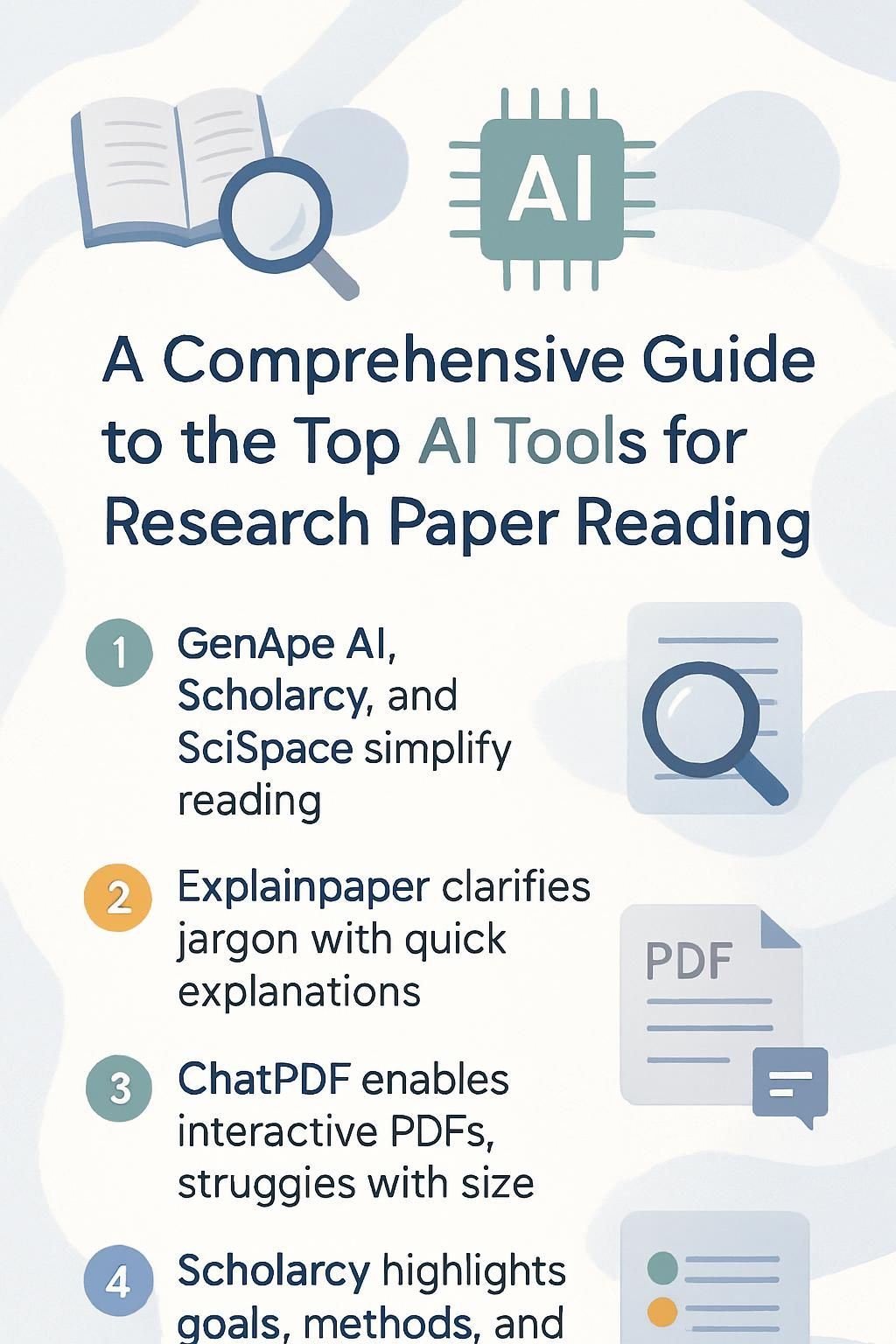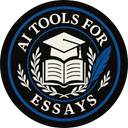Reading research papers can feel overwhelming and time-consuming. AI tools for research paper reading make it easier by summarizing and simplifying complex content. This guide will introduce you to some of the best tools available, like GenApe AI or Scholarcy, that save time and improve understanding.
Keep reading to find the perfect tool for your academic needs!
Key Takeaways
- AI tools like GenApe AI, Scholarcy, and SciSpace Copilot simplify reading academic papers by summarizing key points and breaking down complex ideas.
- Explainpaper helps users understand tough jargon in scientific texts with instant explanations and abstract analysis.
- ChatPDF transforms static PDFs into interactive chats but struggles with dense technical terms or large files.
- Scholarcy quickly summarizes research papers, highlighting study goals, methods, and conclusions for faster reviews.
- Combining tools like Elicit and SciSpace Copilot can save researchers time while improving understanding of difficult topics.

GenApe AI: Simplifying Complex Research Papers
GenApe AI makes reading tough research papers easier and faster. It breaks down complex ideas using natural language processing to help you save time.
Key Features of GenApe AI
GenApe AI makes research paper reading easier. It uses advanced artificial intelligence to save time and boost understanding.
- Simplifies academic research by breaking down complex ideas quickly.
- Offers advanced summarizers to extract key points from scientific papers.
- Provides customizable document analysis for targeted insights into essays or abstracts.
- Generates accurate titles using natural language processing tools, improving clarity in systematic reviews.
- Real-time web access ensures the latest data retrieval from trusted sources like Semantic Scholar or the internet.
- Enables image generation and multimedia support for deeper explanations of trending topics or data analysis in research studies.
- Free trial available without needing a credit card, offering risk-free exploration of its capabilities.
- Users can apply referral code GenApeAI for a 5% discount on subscriptions, making it more affordable for researchers and students alike.
Pros & Cons of Using GenApe AI
GenApe AI makes research paper reading easier by breaking down complex concepts. It offers several features that enhance efficiency and understanding. Below is a clear comparison of its benefits and drawbacks:
| Pros | Cons |
|---|---|
|
|
This comparison outlines the key points, paving the way for the next tool: Explainpaper.
Explainpaper: Breaking Down Academic Jargon
Explainpaper makes reading academic papers easier by breaking down tough words. It helps simplify ideas so you can focus on the core message.
How Explainpaper Works
Explainpaper helps researchers understand academic papers quickly. It simplifies hard concepts and explains technical terms.
- Upload your research paper in PDF format. The tool supports English language texts.
- Highlight any part of the paper that seems unclear or complex.
- Get instant explanations for the highlighted text using natural language processing (NLP).
- Break down complex vocabulary into simpler terms for better understanding of academic jargon.
- Access detailed abstract analysis to quickly grasp the main idea of the paper.
- Use a free account, but note there are limits on file size uploads.
- Save time exploring scientific papers with its real-time help feature for researchers and students alike.
Benefits of Explainpaper for Researchers
Explainpaper helps researchers understand complex academic papers. It simplifies difficult terms and provides clear explanations for English-language texts. This tool can break down scientific jargon, making it easier to grasp key ideas quickly.
Researchers save time by using Explainpaper’s detailed abstract analysis feature. It also offers vocabulary explanations that clarify technical words found in research papers. The free account option allows users to try its helpful features without a full commitment.
ChatPDF: Interactive Research Paper Analysis
ChatPDF makes reading research papers more engaging. Ask questions, and it will provide quick answers from the document!
Features and Capabilities of ChatPDF
ChatPDF helps researchers analyze scientific papers with ease. It offers tools to simplify academic research and improve productivity.
- Built on the GPT-3 language model, it provides smart AI-driven assistance for research papers.
- Offers a split interface for PDF analysis, making it easy to view and interact with content.
- Includes an AI chat interface that answers questions about the paper in simple terms.
- You can interact without needing user registration, saving time and ensuring simplicity.
- Processes lengthy academic jargon into shorter, clearer explanations for better understanding.
- Useful for systematic literature reviews by extracting key insights quickly and accurately.
Explore Explainpaper next to see why it’s a great tool for breaking down complex terms in research papers!
Limitations of ChatPDF
ChatPDF struggles with understanding deeply technical academic research. It may misinterpret complex terms or fail to provide accurate analysis for scientific papers involving statistical data, like meta-analysis or placebo-controlled trials.
Its ability to process large documents might also lag, making it less effective for dense texts full of jargon.
It can’t verify facts from newer sources beyond October 2023. This limits its accuracy when discussing recent heart rate variability studies or cardiovascular health insights. Researchers relying heavily on up-to-date information might find this tool insufficient for literature reviews and advanced academic needs.
SciSpace Copilot: Your AI Research Assistant
SciSpace Copilot makes reading research papers easier with smart tools. It helps highlight key points and simplifies tough concepts.
Core Functions of SciSpace Copilot
SciSpace Copilot serves as a helpful AI research assistant. It simplifies the process of reading and analyzing academic papers.
- Offers instant summaries of research papers, saving time for researchers.
- Highlights key insights, making it easier to grasp complex scientific information.
- Converts dense academic content into more understandable language for better comprehension.
- Supports various languages, including Simplified Chinese, expanding accessibility for global users.
- Provides a browser extension and web-based version, allowing easy integration into daily workflows.
- Uses natural language processing to identify essential data in scientific or academic texts effectively.
- Assists with literature review by organizing findings and reducing manual effort from researchers’ tasks.
Why SciSpace Copilot Stands Out
Building on its core features, the tool offers a browser extension. This makes accessing research papers easier across various platforms. It supports multiple languages, including Simplified Chinese, increasing accessibility for global users.
Designed specifically for academic literature, it simplifies understanding of complex scientific papers. Unlike many tools, it blends advanced AI with an easy-to-use interface. These strengths set it apart as a valuable ai research assistant in tackling challenging academic texts.
Scholarcy: Summarize and Extract Key Insights
Scholarcy uses AI to break down scientific papers quickly. It pulls key points and saves time for readers.
Highlights of Scholarcy’s Functionality
Scholarcy makes reading research papers quicker and easier. It breaks down complex academic content into bite-sized summaries.
- Converts long research papers into concise abstracts using natural language processing.
- Extracts key information, like study aims, methods, and conclusions, to save time.
- Offers customizable summaries aligned with user preferences for better focus on specific details.
- Highlights important sections within the academic text for faster understanding of complex topics.
- Requires simple registration, ensuring access is user-friendly and efficient.
- Enhances literature reviews by summarizing multiple scientific papers in one go.
Next, we’ll examine its impact on improving research efficiency!
Scholarcy’s Role in Research Efficiency
Scholarcy turns dense scientific papers into clear, concise abstracts. It saves time by extracting key insights in seconds. Researchers can even customize summaries to fit their needs.
This tool requires user registration but offers great benefits for academic research and literature review. Developed by Cactus Communications, it’s useful for breaking down complex topics with natural language processing techniques.
Benefits of Using AI Tools for Research Paper Reading
AI tools make reading research papers quicker and easier. They help break down tough ideas into simple bits anyone can understand.
Faster Data Extraction and Simplified Analysis
AI tools make reading and analyzing research papers faster. They quickly extract key points, saving time for researchers. For instance, systematic reviews with Elicit are 80% faster compared to traditional methods.
These tools simplify complex ideas and help identify useful data easily.
Natural Language Processing (NLP) aids in breaking down academic jargon. This makes scientific papers more accessible to everyone. Features like summarization highlight the most relevant parts of a paper without missing critical details.
Improved Understanding of Complex Topics
AI tools break down scientific papers into simple ideas, making tough topics easier to understand. Tools like SciSpace Copilot and Scholarcy help explain academic research by summarizing studies.
They process complex data quickly, saving time for deeper insights.
Large language models (LLMs) analyze patterns in texts and provide clear answers. For example, Explainpaper simplifies jargon-heavy sections of literature reviews. Researchers can now grasp difficult concepts faster, leading to better analysis of academic papers or systematic reviews.
Comprehensive Review of AI Tools for Research Paper Reading
GenApe AI simplifies tough academic papers. It breaks down dense text, making complex ideas clear. Explainpaper helps researchers crack tricky jargon with interactive tools. ChatPDF turns static PDFs into chats for easy analysis.
SciSpace Copilot works as a smart assistant, offering summaries and context quickly. Scholarcy extracts key points and highlights the main ideas of scientific papers in seconds.
Elicit supports 125 million research papers, helping over 2 million researchers save time and money. Pilot projects using Elicit cut costs by 50% while speeding up work by half too.
These tools combine natural language processing with quick data extraction to make research smoother—ideal for deep literature reviews or scientific studies!
Tips for Effectively Using AI Tools in Research
Use these tools smartly to gain deeper insights from academic papers. Explore their features to improve your research efficiency.
Focus on Relevant Features
Focus on features that match your research needs. Tools like GenApe AI simplify complex scientific papers, while Explainpaper breaks down academic jargon easily. ChatPDF offers interactive analysis, helping you engage with content better.
Scholarcy extracts key insights fast and saves time.
Look for privacy options if uploading files is needed. Elicit ensures user data stays confidential, making it safe for sensitive research papers. Prioritize tools with summarizing capabilities to quickly grasp main ideas in academic research or literature reviews.
Combine Tools for Comprehensive Insights
Using multiple AI tools together improves results. GenApe AI simplifies research papers, while Explainpaper breaks down tough terms. ChatPDF lets users interact with academic texts.
Scholarcy quickly summarizes and highlights key points, saving time during literature reviews.
Elicit automates systematic reviews for over 2 million researchers. Combining it with SciSpace Copilot enhances data analysis and understanding of scientific papers. Cross-verifying outputs from different tools reduces errors and deepens insights into complex topics.
Next, explore tips on using these AI tools effectively in research tasks.
Conclusion
AI tools make reading research papers faster and easier. They help you break down tough ideas and save time. Tools like GenApe AI, Explainpaper, ChatPDF, SciSpace Copilot, and Scholarcy offer unique features to meet different needs.
Each tool brings something special to the table for academic research. Try combining them for better results and deeper insights!
For more detailed insights and comparisons of the different AI tools discussed, visit our comprehensive guide to AI tools for research paper reading.


Leave a Reply